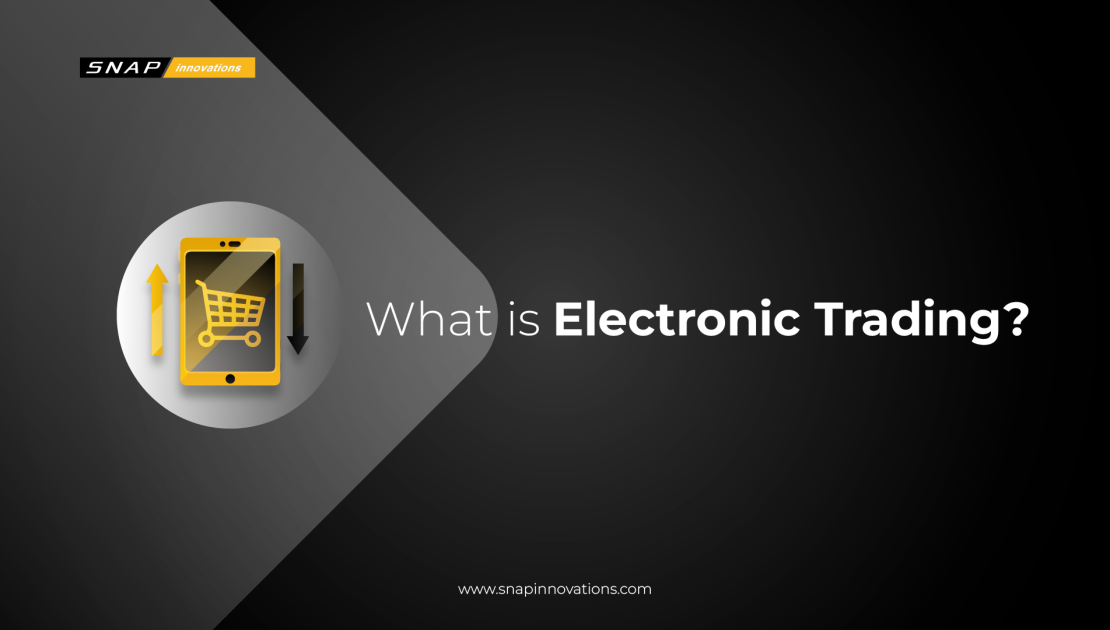In an era where technology engulfs every aspect of our lives, electronic trading has firmly rooted itself at the core of the financial markets. The landscape of buying and selling financial instruments has been revolutionized, making the process more efficient, quick, and cost-effective. As we demystify electronic trading in the paragraphs that follow, a profound understanding of its principles, advantages, practices, and what it holds for the future will be unveiled.
As we navigate through the vast realms of electronic trading, the journey unfolds through real-time buying and selling of financial securities—stocks, bonds, currencies, and a host of other financial instruments—electronically. The marketplace, once cluttered with human traders shouting orders across the trading floor, has now transformed into a sophisticated digital arena where transactions happen in the blink of an eye.
Embarking on this exploration, various facets of electronic trading will unravel, offering insights into its operational mechanisms, the technology that drives it, and how traders around the globe leverage it to optimize their trading strategies. So, fasten your seat belts as we embark on an enlightening voyage through the digitalized trading galaxy.
What is Electronic Trading?
 Electronic trading, in its essence, refers to the practice of executing trading transactions electronically as opposed to traditional floor trading. With the advent of robust technologies and sophisticated trading platforms, it has become the norm in global financial markets, facilitating a seamless flow of transactions with enhanced precision and speed.
Electronic trading, in its essence, refers to the practice of executing trading transactions electronically as opposed to traditional floor trading. With the advent of robust technologies and sophisticated trading platforms, it has become the norm in global financial markets, facilitating a seamless flow of transactions with enhanced precision and speed.
The framework of electronic trading encompasses various components, such as online brokers, electronic trading platforms, and algorithmic trading. These entities collectively form an intricate web that enables investors and traders to buy and sell financial instruments with efficiency and minimal human intervention.
Diving deeper, electronic trading is not just a technical conduit for transaction execution; it represents a dynamic ecosystem. Within its realm, it nurtures a competitive and transparent trading environment, thus opening doors to global markets, lowering trading costs, and improving market liquidity.
Also Read: What is Algo Trading? Revolutionizing Financial Markets
The Evolution of Electronic Trading
 Tracing the origins of electronic trading leads us back to the 1970s when computerized trading embarked on its inaugural journey. Over the decades, it has evolved exponentially, adapting to technological advancements and market demands, thus shaping the contemporary financial trading landscape.
Tracing the origins of electronic trading leads us back to the 1970s when computerized trading embarked on its inaugural journey. Over the decades, it has evolved exponentially, adapting to technological advancements and market demands, thus shaping the contemporary financial trading landscape.
As electronic trading platforms flourished, they marked the decline of traditional open outcry trading floors. The transition didn’t just alter the physical space; it brought about monumental changes in trading practices, strategies, and the overall market structure.
Key technological innovations, such as the internet and advancements in computing power, played pivotal roles in fostering the growth of electronic trading. These advancements catalyzed real-time information flow, broader market access, and the development of sophisticated trading algorithms and tools.
Fast-forwarding to the present, electronic trading stands as a pillar supporting the vast architecture of global financial markets, enabling unprecedented levels of market access, liquidity, and trading efficiency.
The Technology Behind Electronic Trading
 In the symphony of electronic trading, technology plays the role of the masterful conductor, orchestrating a harmonious flow of activities and fostering an environment ripe with innovation and efficiency. From the precision of high-frequency trading algorithms to the robust shields of risk management systems, technology crafts every nuance, every rhythm of the trading process. It is the invisible force that propels the market, enabling the real-time execution of trades, fostering thorough market analysis, and nurturing an ecosystem thriving with advanced trading functionalities and tools.
In the symphony of electronic trading, technology plays the role of the masterful conductor, orchestrating a harmonious flow of activities and fostering an environment ripe with innovation and efficiency. From the precision of high-frequency trading algorithms to the robust shields of risk management systems, technology crafts every nuance, every rhythm of the trading process. It is the invisible force that propels the market, enabling the real-time execution of trades, fostering thorough market analysis, and nurturing an ecosystem thriving with advanced trading functionalities and tools.
Electronic trading platforms emerge as marvelous embodiments of technological sophistication, playing the role of powerful gateways to the boundless realms of the financial markets. These platforms, polished with a spectrum of advanced features, facilitate a plethora of trading activities, allowing traders to voyage through the markets with ease and precision. They are the canvases where traders paint their strategies, using vibrant colors of order placements, market analysis tools, and a diverse array of advanced trading features, weaving the intricate tapestries of their trading visions.
Blockchain technology, along with the dynamic realm of cryptocurrencies, has also stepped onto the stage, each making profound and transformative impacts on the electronic trading landscape. These technological marvels herald a new epoch, sprinkling the trading landscapes with innovative sparks, fortifying security architectures, and weaving new patterns in the fabric of trading strategies and methodologies. They push against the boundaries, extending the horizons, and introducing fresh paradigms that redefine the traditional contours of financial trading.
Moreover, these advanced technologies serve as powerful catalysts in the evolutionary journey of electronic trading, driving a continuous process of transformation and innovation. They are the architects of a new trading era, one marked by enhanced security, innovative strategies, and a widened spectrum of trading possibilities. Through these technological conduits, the realms of electronic trading are continually enriched, moving forward on a path paved with innovation, security, and an ever-expanding array of trading opportunities.
Benefits of Electronic Trading
Electronic trading has emerged as a transformative force, redefining the contours of the trading arena. Its advent has woven a tapestry of advancements, revolutionizing the processes and methodologies involved in trading. Let’s delve deeply into the multitude of benefits that electronic trading brings to the table:
1. Increased Market Accessibility
Electronic trading acts as a powerful passport, granting traders seamless access to a global consortium of financial markets. It obliterates geographical barriers, fostering a sense of interconnectedness and global unity within the trading ecosystem. Traders, irrespective of their locations, can voyage through global markets, exploring a universe of diverse investment avenues. This enhancement in market accessibility not only broadens the horizons of investment opportunities but also nurtures the growth of diversified trading strategies. It cultivates a fertile ground where traders can sow seeds of innovation, exploring, and leveraging a wide array of investment possibilities sprinkled across the global markets.
2. Precision and Speed
Electronic trading embodies an essence of breathtaking precision and extraordinary speed. It has ushered in an era where transactions gallop at a lightning-fast pace, completing trades that once lingered, in a fleeting fraction of a second. This meteoric speed is a formidable ally in harnessing market opportunities and navigating the turbulences of price volatility. The enhanced speed and precision imbue the trading activities with a layer of agility and responsiveness, allowing traders to finely tune their strategies in alignment with the dynamic market rhythms, ensuring that they are always in harmony with the market’s pulse.
3. Enhanced Transparency and Competition
Electronic trading is a beacon of transparency and competitive fairness in the financial markets. It illuminates the markets with the lights of real-time price discovery and tightly-knit spreads, crafting a realm where information is accurate, timely, and accessible. This democratization of information nurtures a competitive equilibrium, where market participants, irrespective of their stature, can stride with confidence and clarity. The heightened transparency propels the market on a trajectory of fairness and integrity, creating an environment where competition flourishes on a level playing field, infused with a spirit of equality and mutual growth.
4. Cost-Effectiveness
Cost-effectiveness shines prominently among the stellar benefits of electronic trading. It has innovatively streamlined the trading processes, pruning the layers of intermediary involvement, and sewing the seeds of cost efficiency. The trimmed and optimized processes resonate with economic vibrancy, reducing transaction costs, and adding a layer of affordability to the trading pursuits. This manifestation of cost-effectiveness isn’t merely a pathway to reduced expenses; it’s a gateway to a democratized trading arena. It invites a broader spectrum of participants to engage with the markets, fostering a diverse and vibrant ecosystem where varied strategies and perspectives intermingle in a harmonious confluence of trading activities.
Challenges and Considerations
Electronic trading, despite its revolutionary impact on the financial markets, brings along its own set of challenges and considerations that necessitate careful navigation and strategic planning:
1. Market Volatility
Electronic trading, characterized by high-frequency and algorithmic strategies, acts as a powerful amplifier of market volatility. Each transaction, swift and decisive, echoes through the market, creating ripples of substantial fluctuations. The sheer volume and speed of these transactions paint the market canvas with strokes of unpredictability, requiring traders to adopt refined risk management strategies. However, it also necessitates a new age of adaptability among traders.
They must be equipped with the tools and acumen to navigate the volatile landscapes, making real-time decisions that align with the rapid market movements. Thus, while electronic trading brings efficiency and innovation, it also demands a heightened level of vigilance and strategic foresight from market participants.
2. Security Concerns
In the digital realms of electronic trading, security stands as a towering priority. The landscapes are fraught with cybersecurity challenges, ranging from data breaches to sophisticated hacking attempts. Protecting sensitive trading information is paramount, necessitating robust cybersecurity infrastructures.
However, security isn’t a one-time fortress; it is an evolving stronghold that must adapt to the emerging threats continually. The realm of electronic trading, thus, requires constant vigilance and up-to-date security protocols to protect the integrity of trading activities and safeguard market participants against evolving cyber threats.
3. Regulatory Compliance
Regulatory compliance is the sturdy backbone supporting the integrity of electronic trading. Ensuring trading activities resonate with established legal and regulatory frameworks is essential in fostering a transparent and ethical trading environment. It underpins the trust that market participants place in the trading ecosystem, ensuring that it operates with fairness and integrity.
Moreover, as the regulations themselves evolve, adapting to the changing legal landscapes becomes a crucial aspect of maintaining compliance. This dynamic interplay between trading practices and regulatory frameworks necessitates a continuous commitment to legal adaptability and ethical consistency in trading operations.
4. Technological Reliability
Technology, the engine driving electronic trading, must exemplify reliability and resilience. Ensuring that the technological systems function seamlessly is fundamental to the fluidity of trading operations. From executing trades to managing various aspects of the trading lifecycle, the technology should operate with precision and consistency.
However, the road is often marred by technological glitches and system outages, posing risks to trading continuity and market stability. Thus, investing in reliable, robust, and resilient technological infrastructures, coupled with continuous monitoring and improvement, becomes a pivotal consideration in the operational success of electronic trading.
The Future of Electronic Trading
Peering into the future, electronic trading appears poised for continued evolution and innovation. Emerging technologies such as artificial intelligence, machine learning, and blockchain are set to further revolutionize the trading landscape, ushering in new possibilities and challenges.
The integration of these technologies will likely enhance trading algorithms, risk management, and overall market analysis, offering sophisticated tools and strategies to traders and investors.
Furthermore, regulatory and technological advancements are anticipated to further mould the electronic trading environment, aiming for enhanced market resilience, integrity, and investor protection.
The dynamic nature of technology and markets implies that electronic trading will continue to evolve, adapting to new trends, technologies, and market needs, thus remaining a pivotal element of the global financial trading ecosystem.
Harnessing the Power of Electronic Trading
For traders and investors willing to harness the full potential of electronic trading, a multifaceted approach is essential. It involves staying abreast of technological advancements, regulatory updates, and evolving market trends and practices.
Knowledge and education play a crucial role. Understanding the intricacies of electronic trading, the technologies that power it, and the strategies that optimize its utilization are key to navigating its landscape effectively and successfully.
Strategic planning and risk management also hold paramount importance. Developing sound trading strategies, incorporating risk management practices, and maintaining a disciplined approach are essential for achieving trading success in the electronic trading arena.
Read More: Order Management : Technologies and Challenges
Conclusion
In conclusion, electronic trading stands as a monumental pillar in the vast architecture of the financial markets. It encapsulates a universe of technologies, practices, strategies, and trends that collectively define the modern trading landscape.
Embarking on the journey through electronic trading, we have unravelled its essence, evolution, technological foundations, benefits, challenges, and its promising future. As we navigate the continuously evolving landscapes of electronic trading, embracing knowledge, strategic prowess, and adaptability emerges as the beacon that guides towards success and innovation in this fascinating domain.


